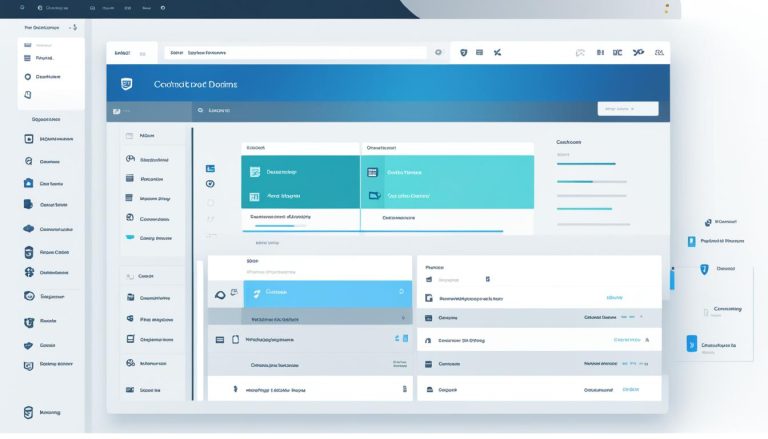What is ETL: Your Guide to Data Integration
Welcome to my guide on understanding ETL, a crucial process in data integration. In this article, I will explain what ETL is, how it works, and why it is essential for businesses in various industries. So, let’s dive in and explore the world of ETL!
Key Takeaways:
- ETL stands for Extract, Transform, Load, and is a process used in data warehousing and business intelligence.
- ETL tools automate the ETL process, making it efficient and scalable.
- Data integration combines data from multiple sources into a unified view, while ETL focuses on extracting, transforming, and loading the data.
- ETL is crucial for data consolidation, ensuring data quality, and enabling improved decision-making.
- Implementing ETL can be challenging, but using the right ETL tools can simplify the process.
What is Data Integration?
Data integration is a crucial process in the world of data management. It involves combining data from different sources and transforming it into a unified view. This ensures that organizations have a comprehensive and accurate understanding of their data, enabling them to make informed decisions.
When it comes to data integration, the first step is gathering data from various sources such as databases, applications, or external APIs. This data may exist in different formats, structures, and locations. The next step is to clean and transform the data, ensuring consistency and compatibility.
Data transformation is a key aspect of data integration. It involves converting data into a standardized format that can be easily analyzed and compared. This may include tasks such as changing data types, aggregating information, or removing duplicates.
Once the data is gathered and transformed, it is then loaded into a central repository, also known as a data warehouse or a data lake. This repository acts as a single source of truth, providing a consolidated view of the organization’s data.
Data integration tools play a significant role in streamlining this process. These tools include ETL (Extract, Transform, Load) tools, data integration platforms, and middleware. They automate data integration tasks, reducing manual effort and ensuring data accuracy.
In summary, data integration is the process of combining and transforming data from different sources to create a unified view. It prepares data for analysis, reporting, and decision-making. By establishing a central repository, organizations can effectively manage and utilize their data, unlocking valuable insights for business success.
Benefits of Data Integration:
- Improved data accuracy and consistency
- Enhanced data analysis and reporting capabilities
- Streamlined decision-making processes
- Efficient data management and governance
- Deeper insights into business operations
What is ETL?
In the world of data warehousing and business intelligence, ETL plays a pivotal role in ensuring the efficient management and utilization of data. ETL stands for Extract, Transform, Load, and it encompasses a series of essential processes that facilitate the integration and consolidation of data from various sources.
The ETL process begins with the extraction phase, where data is collected from disparate sources such as databases, APIs, and file systems. This initial step involves retrieving the relevant data and preparing it for transformation.
Once the data is extracted, it undergoes a transformation process. This step involves modifying, cleansing, and structuring the data to ensure consistency and accuracy. Data transformation may include activities like filtering, aggregating, and applying business rules to standardize the data format.
After the data has been transformed, it is then loaded into a data repository, typically a data warehouse. This repository acts as a centralized storage system that organizes and stores the transformed data for further analysis and reporting.
The significance of ETL lies in its ability to ensure data consistency, accuracy, and accessibility. By extracting data from multiple sources and transforming it into a unified format, organizations can make informed decisions driven by reliable and consistent data.
In order to streamline the ETL process, organizations often utilize ETL tools. These tools automate and facilitate the extraction, transformation, and loading of data, saving time and effort. ETL tools provide features such as data mapping, data cleansing, and workflow management, making the ETL process more efficient and reliable.
Various industries benefit from the implementation of ETL processes. In the retail industry, for example, ETL enables the consolidation of data from multiple sales channels and customer touchpoints, facilitating accurate reporting and analysis. In the finance sector, ETL helps integrate data from different financial systems, enabling organizations to gain a comprehensive view of their financial health. In healthcare, ETL allows the integration of patient data from various healthcare facilities, enabling better care management and analysis.
Example of ETL Process
Let’s consider an example of an ETL process in the context of a retail organization. The ETL process begins by extracting data from point-of-sale systems, online sales platforms, and customer databases. The extracted data, such as sales transactions, customer information, and inventory records, is then transformed, which may involve cleaning the data, standardizing product names, and summing sales figures. Finally, the transformed data is loaded into a data warehouse, where it is available for analysis, reporting, and decision-making.
Benefits of ETL
The ETL process offers several benefits to organizations:
- Consolidates data from multiple sources into a centralized repository
- Improves data quality by standardizing and cleansing data
- Enables accurate and reliable reporting and analysis
- Enhances data accessibility for decision-making
- Automates data integration processes, saving time and effort
Implementing an efficient ETL process empowers organizations to harness the full potential of their data, driving data-driven decision-making and unlocking valuable insights.

| Stage | Description |
|---|---|
| Extract | Retrieve data from multiple sources, such as databases, APIs, and file systems |
| Transform | Modify, cleanse, and restructure the extracted data to ensure consistency and accuracy |
| Load | Transfer the transformed data into a central data repository, typically a data warehouse |
Data Integration vs ETL – Understand the Difference
When it comes to data integration, there are two important processes to consider: data integration itself and ETL (Extract, Transform, Load). While both processes involve integrating data from multiple sources, they have distinct differences in their scope, tools used, output, and data volume.
Scope:
Data integration encompasses a wider range of activities compared to ETL. It involves gathering data from various sources, cleansing it, and combining it into a unified view. This process ensures that data is consistent and ready for analysis, reporting, and decision-making.
On the other hand, ETL focuses specifically on three key stages: extracting data from the source systems, transforming the extracted data to fit the intended target schema, and loading the transformed data into the data warehouse. ETL is primarily concerned with the movement and transformation of data.
Tools:
Data integration can be achieved using a variety of tools, including ETL tools, data integration platforms, and middleware. These tools provide capabilities for data cleansing, mapping, and consolidation. Companies can choose the tools that best suit their specific data integration requirements.
On the other hand, ETL is typically performed using specialized ETL tools. These tools are specifically designed to automate the ETL process, offering features such as data extraction, transformation, and loading. Popular ETL tools in the market include Informatica PowerCenter, Talend, and Microsoft SQL Server Integration Services (SSIS).
Output:
The output of data integration can vary depending on the specific use case. It can result in a consolidated view of the integrated data, where data from multiple sources is combined into a single view. Alternatively, data integration can also produce transformed data that is tailored for specific applications or reporting requirements.
In contrast, the primary output of the ETL process is the transformed data that is loaded into a data warehouse or data mart. This transformed data is structured and optimized for analytical queries, enabling efficient data analysis and reporting.
Data Volume:
When it comes to data volume, ETL typically deals with larger volumes of data compared to data integration. Since ETL is primarily used in data warehousing and business intelligence scenarios, it often involves extracting and processing substantial amounts of data from multiple sources.
Data integration, on the other hand, can handle both large and small volumes of data, depending on the specific needs of the integration process. It is more focused on combining and consolidating data from diverse sources, regardless of the volume.
Conclusion
ETL (Extract, Transform, Load) is a critical component of data-driven organizations. It plays a pivotal role in enabling data consolidation, ensuring data quality, and facilitating improved decision-making. By extracting data from various sources, transforming it into a usable format, and loading it into a data warehouse, ETL processes provide the foundation for data analysis and reporting.
However, ETL processes can present challenges in terms of data quality issues, complex transformations, and scalability. Ensuring the accuracy and consistency of data during the extraction, transformation, and loading phases can be a daunting task. That’s where ETL tools come into play. These tools simplify and automate the ETL process, making it more efficient and less error-prone.
When selecting ETL tools, businesses should consider those that offer pre-built connectors and automation features. These tools streamline the integration of data from disparate sources, improving the overall efficiency of the ETL process. By leveraging the power of ETL tools, organizations can optimize their data integration efforts and make informed, data-driven decisions.
In conclusion, ETL is of utmost importance for businesses seeking to harness the full potential of their data. While it presents challenges, the right ETL tools can greatly simplify and expedite the integration process. By implementing ETL effectively, organizations can consolidate their data, enhance data quality, and gain valuable insights for strategic decision-making.
FAQ
What is ETL?
ETL stands for Extract, Transform, Load. It is a process used in data warehousing and business intelligence to extract data from various sources, transform it, and load it into a data warehouse. ETL ensures data consistency, accuracy, and accessibility for analysis and reporting.
What is data integration?
Data integration is the process of combining data from different sources into a unified view. It involves gathering and cleaning data from various sources, preparing it for analysis, reporting, and decision-making. Data integration tools, such as ETL tools, data integration platforms, and middleware, are used to facilitate this process.
What is the difference between data integration and ETL?
While data integration and ETL are both data integration processes, there are some key differences. Data integration encompasses a wider range of activities beyond ETL, including data consolidation and creating a central repository for storing data. ETL, on the other hand, focuses specifically on extracting, transforming, and loading data. Additionally, data integration can use various tools, while ETL is typically done using specialized ETL tools.
Why is ETL important?
ETL is a critical component of data-driven organizations as it enables data consolidation, data quality, and improved decision-making. By automating the ETL process and ensuring data consistency and accuracy, businesses can leverage their data effectively and make informed, data-driven decisions.
What are the challenges associated with ETL?
ETL processes can be challenging due to data quality issues, complex transformations, and scalability. Ensuring data quality and handling large volumes of data can be time-consuming and require careful planning and monitoring. Additionally, complex data transformations may require extensive coding and testing. Scalability is another challenge, as ETL processes need to efficiently handle increasing data volumes as businesses grow.
What should businesses consider when choosing ETL tools?
Businesses should consider ETL tools that offer pre-built connectors and automation features. Pre-built connectors simplify the integration of various data sources, reducing development time and effort. Automation features help streamline the ETL process, allowing for faster data extraction, transformation, and loading. It is also important to assess the scalability, performance, and ease of use of the ETL tools to ensure they meet the specific needs of the business.
- About the Author
- Latest Posts
Mark is a senior content editor at Text-Center.com and has more than 20 years of experience with linux and windows operating systems. He also writes for Biteno.com






